--29b Streamlined Bus (1936-50)
29b STREAMLINE BUS
The Dinky Toys advertisement in the April 1936 issue of the Meccano Magazine, included the 29b Streamline bus that had most likely just been released with its price being 6d. I state “most likely just been released†as although it does not appear in any earlier Dinky Toys advertisement in the Meccano Magazine this is no real guarantee that the model was not released earlier.


Instead I thought it did appear in a diorama scene that formed part of the Dinky Toys advertisement in the February 1936 issue of the Meccano Magazine.


However a close examination shows this to be possibly a 31 Holland Coachcraft Van, although the way this model has been positioned, was a “sneaky†way of showing either model! Interestingly, the list of models depicted in the diorama has the 3e Newsboy sales number as being 31 the same as the Holland Coachcraft Van, although the same advertisement in the March issue corrected this. Still the list of models does not include either the van/bus in both month’s advertisement.

With the Holland Coachcraft Van having been released in 1935, I often wonder why it suddenly became a bus after less than a year in production and on sale. I also find it interesting that the advertisement for the bus does not show its different colour flash on the roof.
The following are what some publications have said about the 29b Streamline Bus:
From the Richardsons:
29b STREAMLINE BUS was issued in 1936 and is a single casting which mysteriously does not seem to suffer the fatigue of many other pre-war releases. The wheels are concealed within the body, and during its life it ran on white or black tyres, both smooth and treaded. In its brief post-war existence, the tyres are usually smooth black. The pre-war castings all had an open rear window which was rather crudely filled in for post-war issue. The painting was always two-tone, with the spats and roof stripe painted a darker colour than the body. Two-tone green and blue are common, with grey allied with a variety of other colours following close behind, but the most spectacular is probably red with maroon flashes. Post-war, the colours were very similar but the roof flash was no longer applied.
Edward Force
Cast body and hubs, rubber tyres. Casting with open rear window, two grooves from window to end of body (1935-1940)
Red body, maroon trim
Light green body, dark green trim
Medium blue body, dark blue trim
Grey body, dark blue trim
Grey body, dark grey trim
Casting without window or grooves (1948- 1950)
Cream and red body
Light and dark green body
Light and dark blue body
Grey and red body
Grey and blue body
1936-41
REMARKS: Single casting, no name or number, open rear window, white or black tyres
1945-50
REMARKS: Closed rear window, black hubs, small black tyres
Having written all this, what brought on this lengthy dissertation? Well, a few days ago I received a two-tone green 29b Streamline bus that I won at an auction not far from Sydney, New South Wales. The model was described as being prewar, however, the model has ridged hubs that should identify it as being postwar, but it has the open rear window, two parallel grooves going down the back from the window in which is dark green that extends across the top of the roof and ending in an arrow shape above the windscreen centre pillar.






So what do I have? With my model not appearing in any of the published information on the 29b Streamline Bus, is it possible that the model is a very early postwar issue? If so, why is it that it does not appear in any publication, unless I have over-looked something!
Regards
Bruce
Hello Bruce,
I have two post war 29b Streamline Bus in my collection with the pre war color scheme and open rear window. One in green as yours is and one in two tone blue. Many models were produced using pre war casting and features in 1946 when the factory resumed production.
Open windows, baseplates with slots for figures, smooth hubs. In my opinion the only feature determining pre or post war is the thickness of the axles. Thin axles pre war and thick axles post war.
Kind regards,
Rob
Hello Rob and Bruce,
Indeed the only way to prove if a model is pre- or postwar are the axles. Thick is always postwar.
In my collection several original technical drawings and on all the diameter of the holes for axles are altered in 1945.
38a Fraser Nash BMW 28-8-1945,
38b Sunbeam Talbot 24-8-1945,
38c Laganda 25-8-1945,
38d Alvis 28-8-1945,
23e Speed of the wind 25-8-1945.
I presume all other drawings were altered also in august 1945 and production could started again.
So the old smooth hubs could not fitted anymore because of the small holes. Conclusion the smooth hubs were produced for a very short time in 1945/1946 with bigger holes.
More pre war features were used on early post war models such as closed steering wheels, silver baseplates etc.
John.
Bruce,
I have a addition on your list of colours for the 29b pre war Streamline bus.
Body Trim on roof and wheel arches
Dark blue/ light blue,
Light blue/ red,
White/ dark blue,
Red/ maroon,
Cream/ dark blue.
There are also models with paint on lower body and another on windows and the roof.
Body Upper half of model
Dark blue/ white,
Green/ cream,
Maroon/ cream,
yellow/ cream.
Some two years ago these models were sold from the collection of my friend J.S.
In my own collection Red with cream upper half, dark blue with cream.
And also these models can suffer badly from fatigue.
I have no list of post war colours as I only collect and register the pre war items.
John.
Morning Rob and John (or evening where you are right now!)
Many thanks for your responses. Indeed I know of the thicker axles and ridged hubs for the postwar models, but what I was endeavouring to find out if this version has been recorded somewhere, as I knew there would have been plenty more "out there"! It is for that reason that my last paragraph included the following:
So what do I have? With my model not appearing in any of the published information on the 29b Streamline Bus, is it possible that the model is a very early postwar issue? If so, why is it that it does not appear in any publication, unless I have over-looked something!
Nice to see Rob that you have the same colour scheme. So we have this scheme and the two-tone blue. Now to locate more that can fall into this same category! John is there any chance of you posting pictures of all yours - eventually?? It would be great to add these to this Thread, so that anyone wishing to check on a 29b can do so right here!
Anyway, I bought the 29b with the intention of moving it on, but now that I have it in my hands, its condition was far better than expected, and it is the first of the postwar models so it will stay with me now!!
I should have included this in my first post, does anyone have any theories regarding the two circular marks behind the rear axle and in front of the front axle in the photograph showing the right or driver's side? (It is an English bus so the "driver" would be on the right!)
Kind regards
Bruce
Bruce
Most interesting thread on this often overlooked little bus. I have 2 of these, so took a closer look. One is definitely a later issue, two-tone green, with no rear window, and ridged black wheels, and no roof stripe.
My other one, however, is more like yours. It is two-tone blue, with the roof stripe, and open rear window. But it also has smooth black wheels and the small ridged tires, and thicker axles, so is post-war. I am guessing that mine was made very early after they resumed production. I will have to post some photos tomorrow.
And by the way, both of mine also have those same raised circular areas on the right side, although the later green one's are very faint. I wonder if they were some sort of ejecting mark?
Regards,
Terry
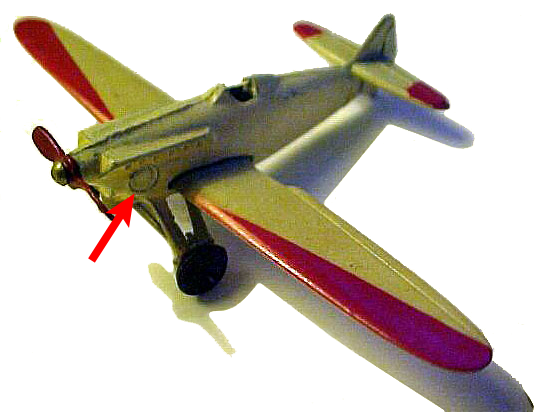
Bruce,
The circles must be ejector marks. The rare late French planes # 60e Dewoitine 500 shows similar marks.
Your bus is not documented because people who have written books copy each other and have not seen enough models. Also once the book is printed one can not add anything any more.
Mike Richardson was complaining about the lack of information and documents, this is what he wrote as a foreword to the Dinky Toys Encyclopaedia :
It gives me great pleasure to write this introduction for my long-standing friend, Jacques Dujardin, who has been relentlessly researching all variations in the colours, assembly methods, wheels, tyres, castings, etc... etc... over many years. Little did Sue and I know when we started collecting in the 1960s that we were witnessing the beginning of a truly great, worldwide hobby. One problem we faced then was the lack of documentation on the subject, a problem relieved to a large extent by Dr. Cecil Gibson's book the History of British Dinky Toys, 1934 to 1964, which was published in hardback form with a print-run of only 750 copies. Such was the rapid growth of the hobby that, when we took over the publication of this book in 1973, we sold over 10,000 copies by 1981 when the first New Cavendish book, Dinky Toys and Modelled Miniatures, effectively replaced it. This book was produced until the arrival of the Great Book of Dinky Toys in 2000. Each new book contained new information gleaned from collectors all over the world. Everyone co-operated to improve the quality, and increase the amount, of the combined knowledge on our favourite subject, Dinky Toys.
With the rapid improvement in methods of handling information on the internet by the use of the new computer technology it was only a matter of time before the vastly increased mountain of knowledge would go digital. Sue would have been very happy to have seen the arrival of this latest method of handling data to bring it to an even wider audience than before. It was always in the forefront of our minds that we were only temporary custodians of the information and that it really belongs to everybody. I welcome this new development from Jacques and we would both wish him every success with it and hope that he receives the amount of help in research that Sue and I got from all the Dinky collector friends out there.
Mike Richardson
October 2010
The internet has made it possible to communicate with collectors all over the world and to obtain a huge amount of information. There is sometime so much that it is difficult to sort it out and enter it in the Encyclopaedia.
The 29b like the 23 and 23a have so many variations that it is almost impossible to list them all. The information is often uncomplete. One can find a nice picture of a model but how is the underneath ? has it got thin or thick axles ? did the light affect the colour ? etc... So some variations may remain unlisted for many years until all the caracteristics of a model are known.
Hello,
I have collected many pictures of pre war models from swapmeets, friends, auctions and Ebay. For me it is not possible to publish these without permission to avoid problems. So I only provide pictures for the Forum from my own collection. The other pictures I keep for my personnel records.
This bus had a rough live. It has thin axles, rear window, blue smooth hubs, no fatigue.
Inside you can see the tipical way of rough spraying with spots of cream colour. I presume some child had a lot of fun playing with this bus.
John.
Lovely Pre War bus John, is there any blue overspray inside? I thought possibly not if the cream was sprayed first, masked, then the blue applied?
Chris Warr.
Hello Chris
No there is no blue paint inside so probably sprayed with mask.
Another bus from my collection. Red with cream roof. Not sure if the black paint is original but a examined this very serious and it seems to me very old. It is already 35 years in my collection and still looks great. Of course with all pre war features.
John.
Here are the photos of my two Streamline buses. As I mentioned earlier, the two-tone blue appears to be a very early post--war issue, as it not only has the roof stripe and open window, but if you look carefully you can see that it also has the smooth black wheels along with the pre-war type small tread tires. Unfortunately, it has been quite scratched up....not nearly as nice as Bruce's. The second one is my later issue, green version, but without the open rear window and the twin grooves under it. You can see slight remaining marks from where it was. I wonder what those twin grooves were supposed to represent? Was there ever a prototype bus with this design, or was this just a "bus creation" based on the Holland Coachcraft van?
Regards,
Terry
Those twin grooves are quite deep
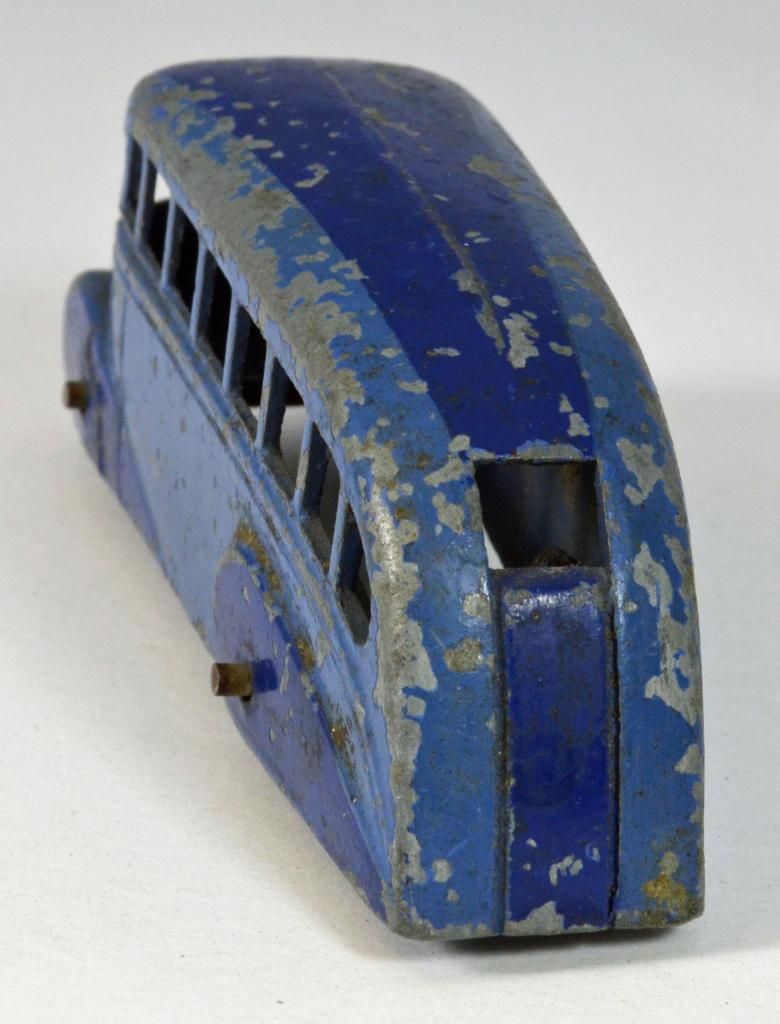
This clearly shows the smooth wheels and the tread style early tires
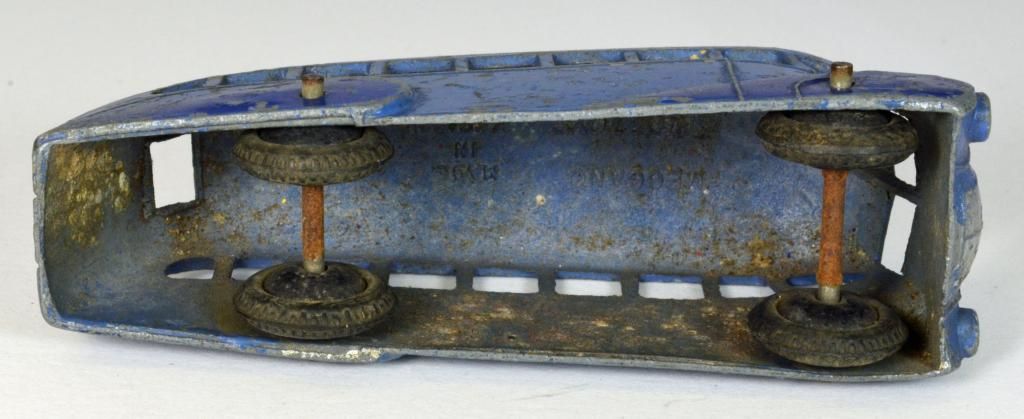
My later issue green Streamline bus
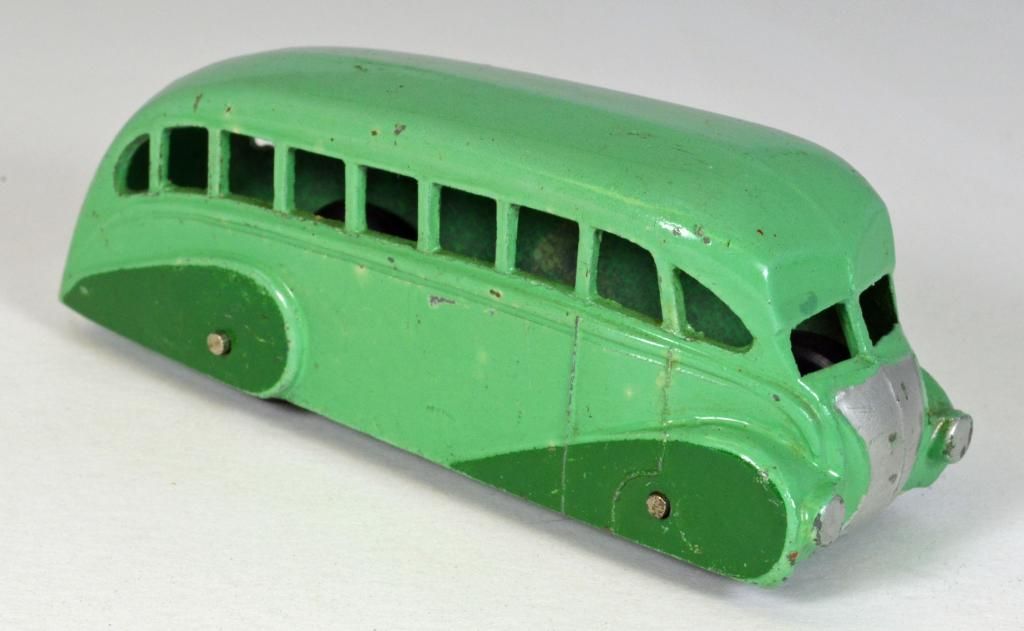
You can see the remains of the twin grooves below the paint, where the die was modified
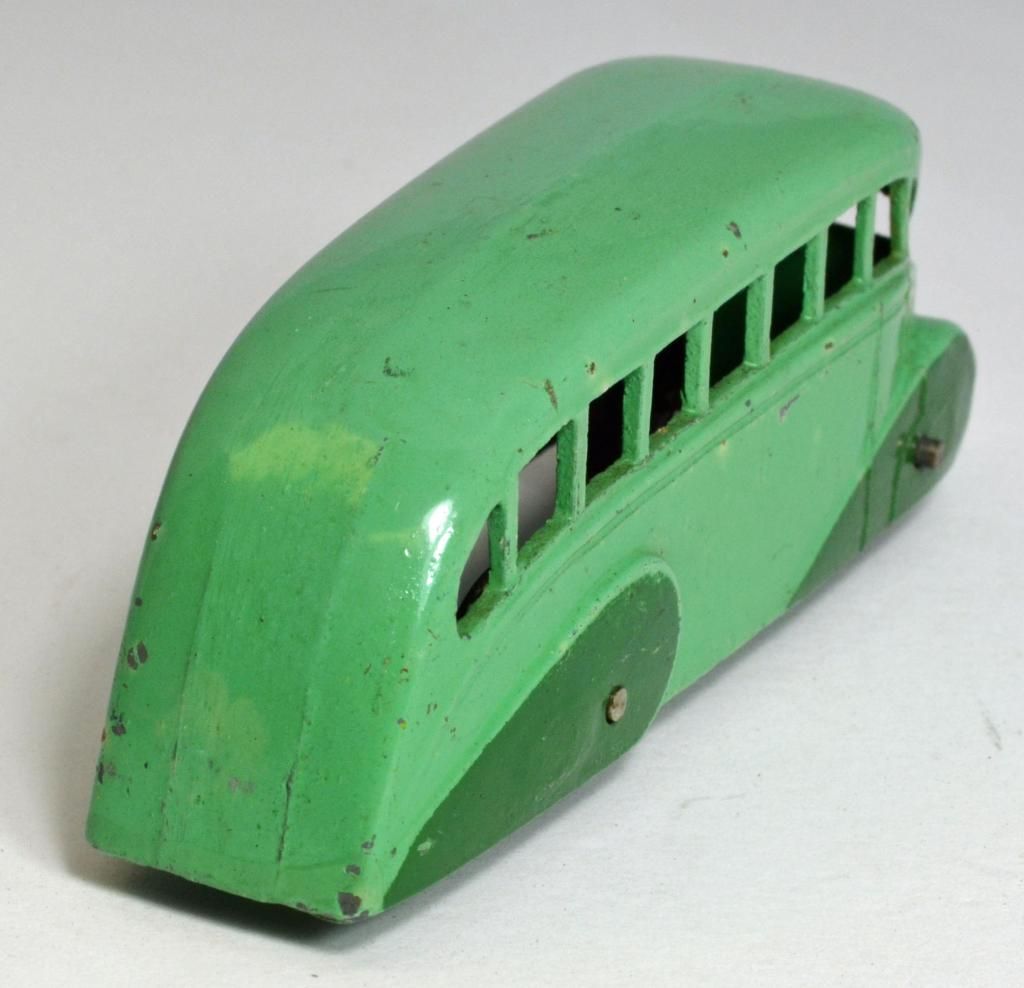
As I explained for the #27F Plymouth Estate car, the die for the streamlined bus was made of four slides. One for each side joinning on the roof center line, one for the front and one for the rear including the rear window. The two deep groves are to hide the seem between the slides.
Nice post digging and lovely coaches indeed.
Some comparative pictures of three post-war versions of the Streamlined Bus.
Light green with dark green spats and roof flash, open rear window and smooth hubs (late 1945-early 1946).
Light grey with red spats only, open rear window and ridged hubs (late 1946-early 1947).
Light green with dark green spats only, closed rear window and ridged hubs (1947-1950).
Comments welcome!
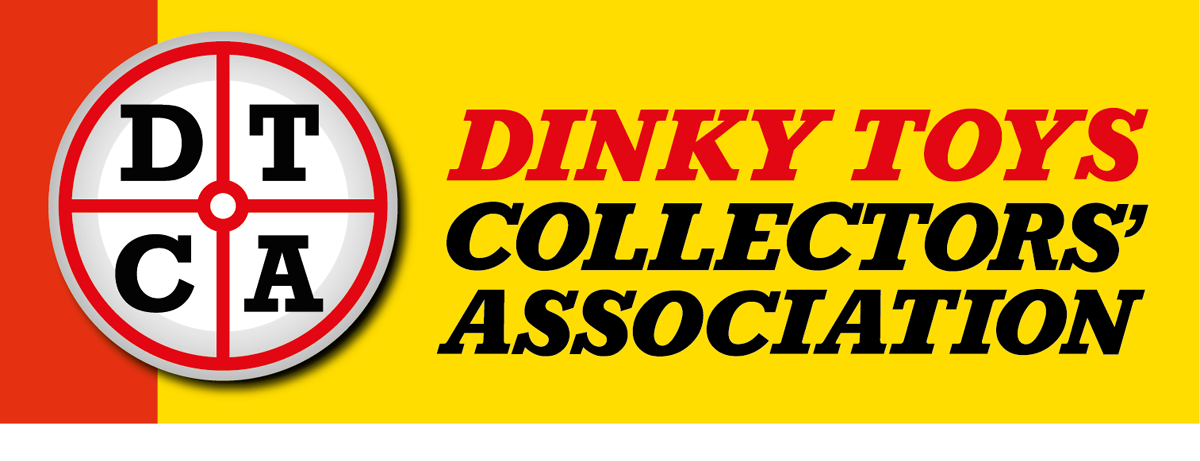

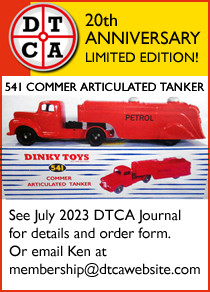
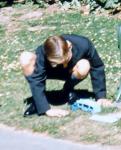

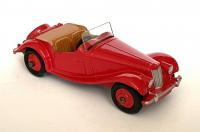
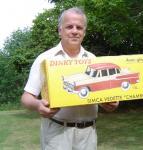
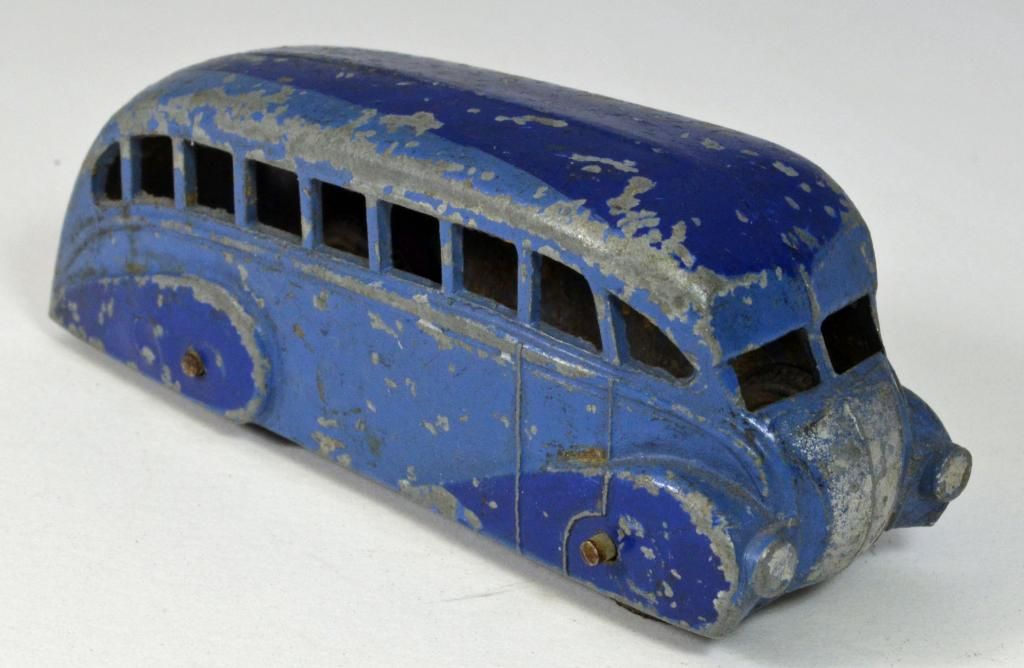
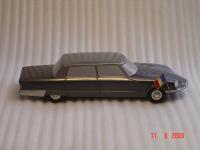

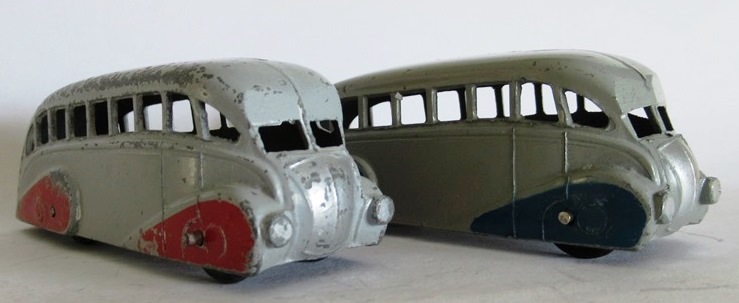

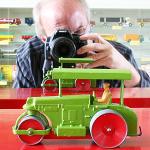
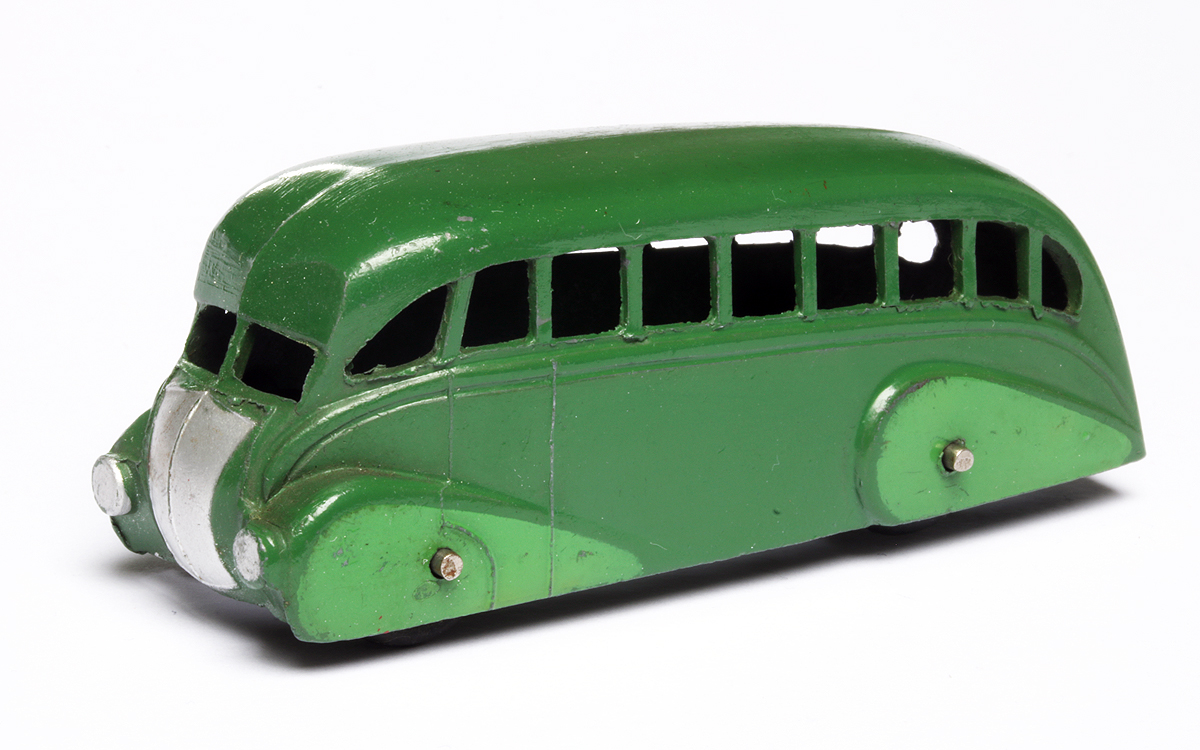
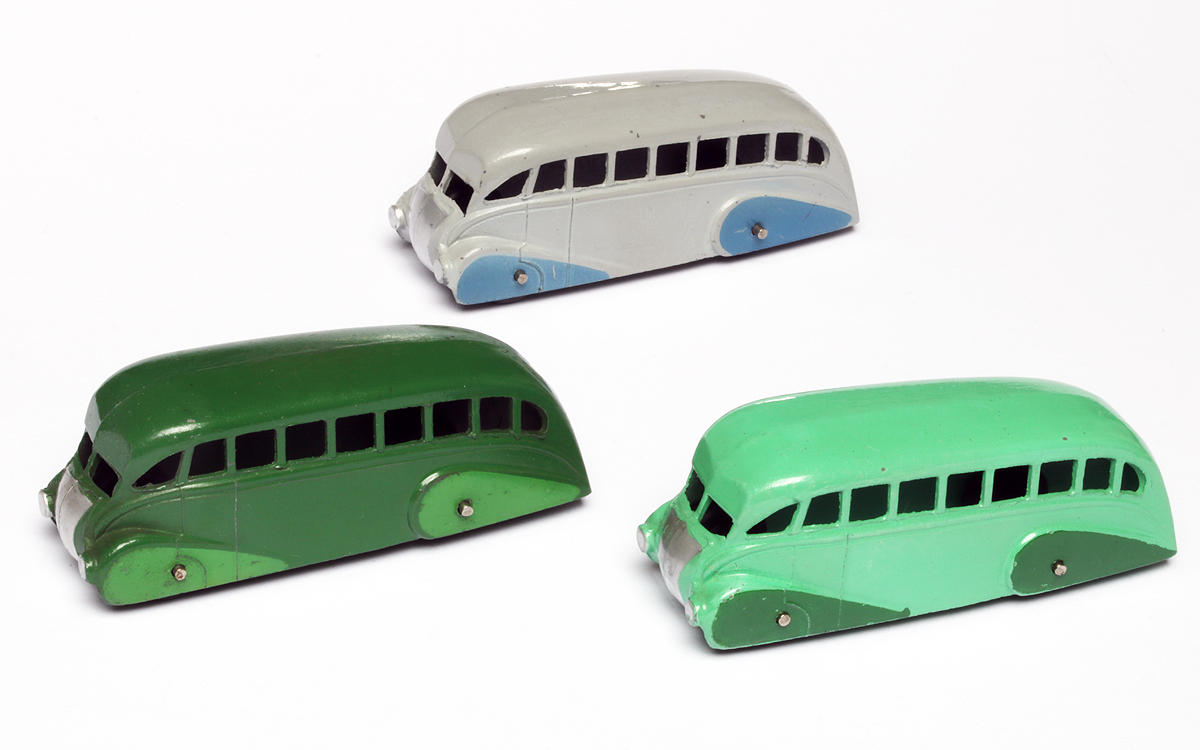
-073 Land Rover, Horse Box and Horse (1960-67)
DTCAwebsite upgrade 2023
DTCAwebsite upgrade 2023
-105c and 383 4-Wheel Hand Truck (1949-1958)
-105c and 383 4-Wheel Hand Truck (1949-1958)
DTCAwebsite upgrade 2023
DTCAwebsite upgrade 2023
DTCAwebsite upgrade 2023
DTCAwebsite upgrade 2023
DTCAwebsite upgrade 2023
DTCAwebsite upgrade 2023
DTCAwebsite upgrade 2023
DTCAwebsite upgrade 2023
DTCAwebsite upgrade 2023
DTCAwebsite upgrade 2023
DTCAwebsite upgrade 2023
DTCAwebsite upgrade 2023
DTCAwebsite upgrade 2023
--22c Motor Truck (1933-50)
--22c Motor Truck (1933-50)
DTCAwebsite upgrade 2023
DTCAwebsite upgrade 2023
Trailer Caravans
Trailer Caravans
DTCAwebsite upgrade 2023
DTCAwebsite upgrade 2023
DTCAwebsite upgrade 2023
DTCAwebsite upgrade 2023
Trailer Caravans
Trailer Caravans
-138 Hillman Imp (1963-73)
-537 Renault 16 TL
-189 Triumph Herald Saloon (1959-64)
-255 Mersey Tunnel Police Van (1955-61)
DTCAwebsite upgrade 2023